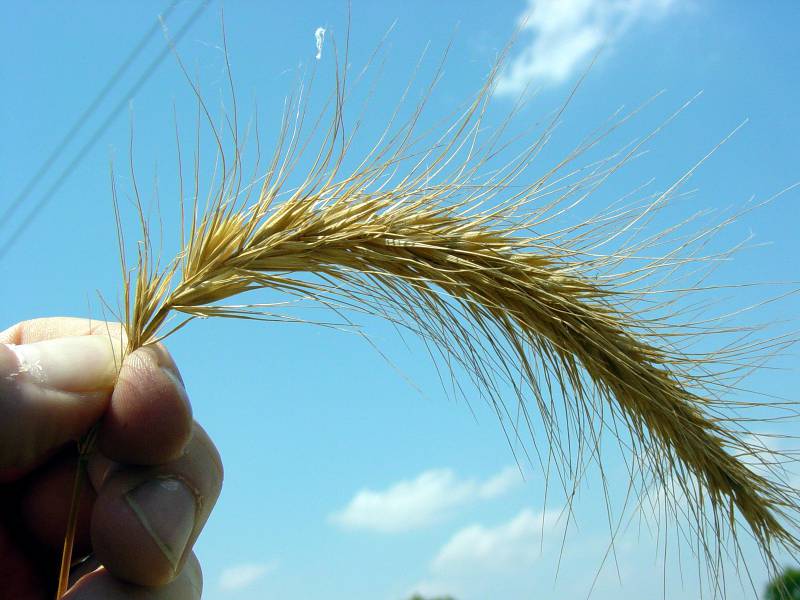Elymus canadensis
Elymus elymoides
Canadian wild rye
bottlebrush, squirreltail
Sheaths open, usually glabrous;
auricles well-developed;
ligules 0.5-1.5 mm. long, with fine marginal hairs;
blades flat, coarse, usually scabrous, 7-15 mm. broad, often glaucous.
Sheaths open;
auricles less than 1 mm. long, sometimes lacking;
ligules membranous, barely 0.5 mm. long;
blades flat to folded or involute, 1-4 mm. broad.
Inflorescence a single terminal spike 10-20 cm. long, often drooping, the upper spikelets crowded, the lower barely overlapping;
spikelets articulate above the glumes, 2- to 6-flowered, borne flatwise on the rachis, 2 per node;
glumes scabrous, hardened, the base spreading, the awn slender and divergent;
lemmas scabrid-pubescent, the body 10-15 mm. long, tapered gradually into a divergent, scabrid awn up to 3.5 cm. long;
paleas nearly as long as the body of the lemmas.
Inflorescence a single terminal spike 3-15 cm. long, often partly included in the upper sheath, the rachis readily disarticulating;
spikelets 1- to 6-flowered, usually 2 per node, borne flatwise on the rachis;
glumes 1- or 2-nerved, simple to bifid, tapering to 1-2 divaricate awns 3-10 cm. long;
florets varying from all fertile to all but one sterile;
lemmas scabrous to puberulent, 5-nerved, the main nerve extending into an awn about equal to the glumes, the 2 lateral nerves often extended and bristle-like;
paleas 2-nerved, the nerves often extended into bristles up to 5 mm. long.
Elymus canadensis
Elymus elymoides
- Local floras:
BC,
OR,
WA
- Local Web sites:
Flora NW,
PNW Herbaria
WildflowerSearch
iNaturalist (observations)
USDA Plants Database
- LBJ Wildflower Center
- SEINet
- Plants of the World Online
- Encyclopedia of Life
- Wikipedia
- Google Image Search
- Local floras:
BC,
CA,
OR,
WA
- Local Web sites:
CalFlora,
CalPhotos,
Flora NW,
PNW Herbaria
WildflowerSearch
iNaturalist (observations)
USDA Plants Database
- LBJ Wildflower Center
- SEINet
- Plants of the World Online
- Encyclopedia of Life
- Wikipedia
- Google Image Search



